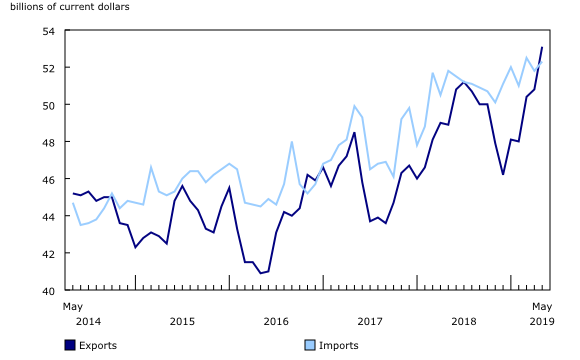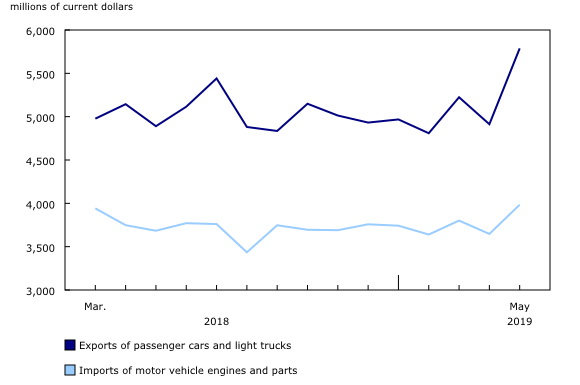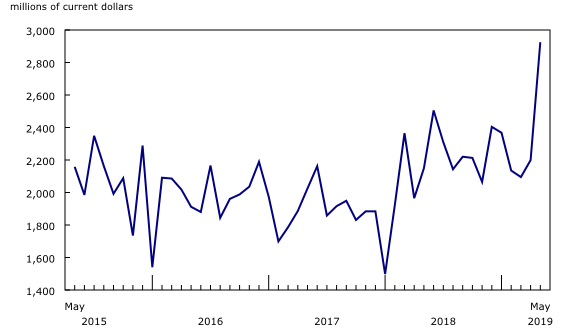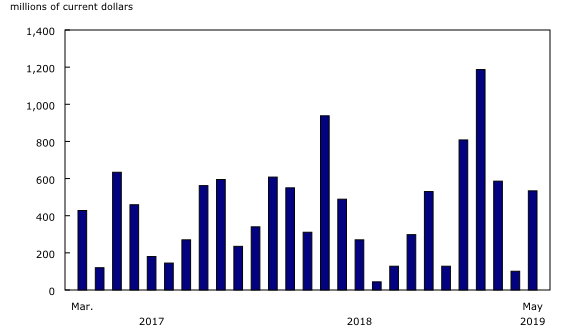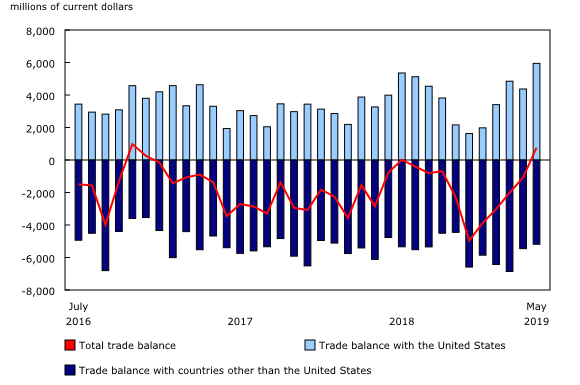Canadian international merchandise trade, May 2019
Archived Content
Information identified as archived is provided for reference, research or recordkeeping purposes. It is not subject to the Government of Canada Web Standards and has not been altered or updated since it was archived. Please "contact us" to request a format other than those available.
Released: 2019-07-03
Canada's merchandise trade balance with the world was in a surplus position in May for the second time since December 2016. The $762 million surplus in May followed a $1.1 billion deficit in April. Exports rose 4.6% in May, in part due to an increase in exports of motor vehicles. Imports were up 1.0%, mainly on higher imports of aircraft.
In real (or volume) terms, exports increased 4.0% and imports were up 1.2%.
Widespread increase in exports
Total exports rose 4.6% to a record $53.1 billion in May, with 9 of 11 product sections posting increases. Exports of motor vehicles and parts, aircraft and other transportation equipment and parts, and energy products contributed the most to the increase. Year over year, total exports were up 8.6%. In May, non-energy exports rose 4.5%.
Exports of motor vehicles and parts were up 12.4% in May to $8.4 billion. Exports of passenger cars and light trucks (+17.8%) contributed the most to the increase, mainly due to higher Canadian motor vehicle production. The increased production was partly due to the resumption of activities at some assembly plants following atypical shutdowns in April. Through the first five months of 2019, exports of passenger cars and light trucks were up 2.8% compared with the same period in 2018.
Exports of aircraft and other transportation equipment and parts (+33.0% to $2.9 billion) also contributed to the overall increase. Exports of boats and other transportation equipment almost quadrupled as a result of higher exports of other transportation equipment to Saudi Arabia. Exports of aircraft (+40.2%) also increased in May, primarily because of increased shipments of business jets and commercial aircraft, particularly to the United States.
Exports of energy products rose 5.0% in May to $10.8 billion. Exports of crude oil were up 2.8%, the fifth consecutive monthly gain, mainly on higher prices. After falling 16.5% in April, exports of refined petroleum products rose 20.4% in May, mainly due to higher exports of heavy fuel oil to the United States.
Higher imports of aircraft
Following a 1.2% decline in April, total imports rose 1.0% to $52.3 billion in May, with 6 of 11 product sections posting increases. Higher imports of aircraft, as well as motor vehicle engines and motor vehicle parts, contributed the most to the overall increase. Year over year, total imports were up 1.1%.
Imports of aircraft and other transportation equipment and parts rose 14.2% to $2.2 billion. After declining by more than $1 billion in March and April combined, imports of aircraft were up by $433 million in May, primarily due to increased shipments of airliners from the United States and Europe.
Imports of motor vehicles and parts increased 1.6% in May to $9.8 billion. As observed in exports of passenger cars and light trucks, imports of motor vehicle engines and motor vehicle parts (+9.2%) rose as a result of increased production in assembly plants.
Trade surplus with the United States at its highest level in more than a decade
Exports to the United States rose 3.7% to a record $39.3 billion in May. Imports from the United States declined 0.5% to $33.3 billion. As a result, Canada's trade surplus with the United States widened from $4.4 billion in April to $5.9 billion in May, the largest surplus since October 2008. Comparing the average exchange rates of April and May, the Canadian dollar lost 0.4 US cents relative to the American dollar.
Exports to countries other than the United States rose 7.3% to a record $13.8 billion in May, partly due to an increase in exports to Saudi Arabia (other transportation equipment). Higher exports to Japan (copper, coal), South Korea (metal ores) and the Netherlands (energy products, iron ores) also contributed to the increase. A significant decline in exports to the United Kingdom (gold) partially offset these increases.
Imports from countries other than the United States rose 3.7% in May to $19.0 billion. Higher imports from Saudi Arabia (crude oil) and Norway (motor gasoline, crude oil) contributed the most to the overall increase.
As a result, Canada's trade deficit with countries other than the United States narrowed from $5.5 billion in April to $5.2 billion in May.
Revisions to April exports and imports
Revisions reflect initial estimates being updated with or replaced by administrative and survey data as they become available, as well as amendments made for late documentation of high-value transactions. Exports in April, originally reported as $50.7 billion in the last release, were revised to $50.8 billion. April imports, originally reported as $51.7 billion in the last release, were revised to $51.8 billion in the current month's release.
Notice to users of the Canadian International Merchandise Trade Database
Please note that for the release of July 3, 2019, the Canadian International Merchandise Trade Database will not be available with data from the latest reference period at 8:30 a.m. Due to technical issues, the entire database will be off-line starting at 8:30 a.m. and will be available again once the new data have been loaded. We expect this process to take approximately three hours. We apologize for the inconvenience.
Note to readers
Merchandise trade is one component of Canada's international balance of payments (BOP), which also includes trade in services, investment income, current transfers and capital and financial flows.
International trade data by commodity are available on both a BOP and a customs basis. International trade data by country are available on a customs basis for all countries and on a BOP basis for Canada's 27 principal trading partners (PTPs). The list of PTPs is based on their annual share of total merchandise trade—imports and exports—with Canada in 2012. BOP data are derived from customs data by making adjustments for factors such as valuation, coverage, timing and residency. These adjustments are made to conform to the concepts and definitions of the Canadian System of National Accounts.
For a conceptual analysis of BOP versus customs-based data, see "Balance of Payments trade in goods at Statistics Canada: Expanding geographic detail to 27 principal trading partners."
For more information on these and other macroeconomic concepts, see the Methodological Guide: Canadian System of Macroeconomic Accounts (13-607-X) and the User Guide: Canadian System of Macroeconomic Accounts (13-606-G).
Data in this release are on a BOP basis and are seasonally adjusted. Unless otherwise stated, values are expressed in nominal terms, or current dollars. References to prices are based on aggregate Paasche (current-weighted) price indexes (2012=100). Volumes, or constant dollars, are calculated using the Laspeyres formula (2012=100).
For information on seasonal adjustment, see "Seasonally adjusted data – Frequently asked questions."
Revisions
In general, merchandise trade data are revised on an ongoing basis for each month of the current year. Current-year revisions are reflected in both the customs and BOP-based data.
The previous year's customs-based data are revised with the release of the January and February reference months, and then on a quarterly basis. The previous two years of customs-based data are revised annually and revisions are released in February with the December reference month.
The previous year's BOP-based data are revised with the release of the January, February, March and April reference months. To remain consistent with the Canadian System of Macroeconomic Accounts, revisions to BOP-based data for previous years are released annually in December with the October reference month.
Factors influencing revisions include the late receipt of import and export documentation, incorrect information on customs forms, replacement of estimates produced for the energy section with actual figures, changes in classification of merchandise based on more current information, and changes to seasonal adjustment factors.
For information on data revisions for crude oil and natural gas, see "Revisions to trade data for crude oil and natural gas."
Revised data are available in the appropriate tables.
Real-time data table
Real-time table 12-10-0120-01 will be updated on July 15.
Upcoming release of trade data by industry
Today, Statistics Canada is releasing monthly data for Canadian international merchandise trade by industry for the period of January 2002 to May 2019. Table 12-10-0136-01 will be updated every month.
The Methodological Guide: Canadian System of Macroeconomic Accounts (13-607-X), a user guide comparing Canadian merchandise imports and exports by industry from three of Statistics Canada's programs, is now available. This guide aims to help users to select the appropriate table when using import and export data by industry.
Next release
Data on Canadian international merchandise trade for June will be released on August 2.
Products
Customs-based data are now available in the Canadian International Merchandise Trade Database (65F0013X).
The updated Canada and the World Statistics Hub (13-609-X) is now available online. This product illustrates the nature and extent of Canada's economic and financial relationship with the world using interactive graphs and tables. This product provides easy access to information on trade, investment, employment and travel between Canada and a number of countries, including the United States, the United Kingdom, Mexico, China, Japan, Belgium, Italy, the Netherlands, Spain and many others.
Contact information
For more information, contact us (toll-free 1-800-263-1136; 514-283-8300; STATCAN.infostats-infostats.STATCAN@canada.ca).
To enquire about the concepts, methods or data quality of this release, contact Benoît Carrière (613-415-5305; benoit.carriere@canada.ca), International Accounts and Trade Division.
- Date modified:



